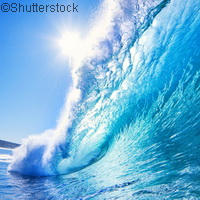A sea-change in CO2 data records
Scientists have gained a new tool in their efforts to research the world's changing environment: the Surface Ocean CO2 (carbon dioxide) Atlas (SOCAT). This is the most comprehensive dataset of surface water carbon dioxide measurements for the world's oceans and coastal seas, made up of 6.3 million global observations generated from research vessels, commercial ships and moorings around the world since 1968. The information provides researchers with a 40-year record of CO2 accumulation in the surface ocean. The study was funded in part by the CARBOOCEAN and CARBOCHANGE projects, which received EUR 14.5 million and EUR 7 million under the EU's Sixth and Seventh Framework Programmes (FP6, FP7), respectively. It is estimated that oceans store 93% of the world's CO2; the remaining 7% is stored in the land biosphere and in the atmosphere, which at about 750 petagrams of carbon holds the least amount of carbon. However, this CO2 storage comes at a cost: the more CO2 that is stored, the less heat the ocean can absorb. Another result is that the more CO2 is absorbed, the more acidic the waters get. The more acidic the water, the more aquatic life is adversely affected. Mussels, for example, cannot create their protective shells, and coral - composed of the same material - could be affected as well. So it is of utmost importance to increase our knowledge of the year-to-year and decade-by-decade changes in ocean CO2 absorption if scientists are to accurately assess the feedbacks between climate change and the ocean carbon cycle. A team of more than 100 scientific experts from all around the world put together this new dataset. Dr Dorothee Bakker of the University of East Anglia (UEA) in the United Kingdom, which spearheaded the efforts, said: 'Assembling this dataset has been a major undertaking by sea-going marine carbon scientists from across the world for the last four years. We believe SOCAT will become an invaluable resource for anyone studying the ocean carbon cycle and its influence on global temperatures.' Gathering the information was only part of the challenge. Once the data had been collated, it had to be combined and presented in a format that could be easily understood by other researchers wishing to find out more. This part of the effort was undertaken by Dr Are Olsen from the Bjerknes Centre for Climate Research in Norway, which physically assembled the dataset. Dr Olsen said, 'The unique aspect of this dataset is that the observations have been combined into a single uniform format and quality controlled. Reformatted input data and recalculated output data are publicly available at www.pangaea.de. The methods we have used are transparent and fully documented.' This information is now freely available over the Internet and includes a sophisticated online data visualisation and manipulation tool called the Live Access Server. This server provides interactive maps that enables users to interrogate the data. 'Our objective from the beginning was to make these products freely available to everyone. We are excited to see how the data will be used by professional and amateur scientists alike,' commented Dr Christopher Sabine from the NOAA's Pacific Marine Environmental Laboratory in the United States. CARBOOCEAN ('Marine carbon sources and sinks assessment') aimed to create an accurate assessment of the marine carbon sources and sinks, while CARBOCHANGE ('Changes in carbon uptake and emissions by oceans in a changing climate') sought to provide the best possible process-based quantification of net ocean carbon uptake under changing climate conditions using past and present ocean carbon cycle changes for a better prediction of future ocean carbon uptake.For more information, please visit: SOCAT: http://www.socat.info/(opens in new window) CARBOOCEAN: CARBOCHANGE: http://cordis.europa.eu/projects/rcn/97547_en.html(opens in new window)
Countries
Norway, United Kingdom, United States



